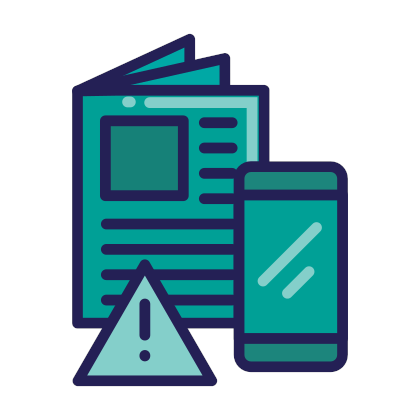Tackling discrimination

Schools can tackle discrimination by promoting democracy, respect for human rights and citizenship.
To ensure that all students’ needs are met equally, schools need to prioritise language and cultural competences, multiperspectivity in history and gender equality. In this way, students can acquire competences for democratic culture, to fulfil their potential in school as well as in society.
Facts & figures
Students with disabilities in Europe have higher early-school leaving-rates than their same-age peers.[1]
Black Caribbean students are three times more likely to be excluded from English schools than white pupils. [2]
A survey of nine EU countries showed that 33% of Roma students were in schools where most pupils were Roma, with 13% in Roma-only schools.[3]
What is discrimination?
Discrimination is treating a person badly or unfairly on account of a personal characteristic, such as national, ethnic or social origin, gender, language, religion, disability or sexual orientation.
There are two basic forms of discrimination:
- Direct discrimination – treating someone less favourably than you treat or would treat another person in the same situation, e.g., a school refusing to admit a student because they are Roma,
- Indirect discrimination – applying a provision, criterion or practice in the same way for all of a group which has the effect of unfairly disadvantaging people in the group who share a particular characteristic, e.g., a school uniform policy banning headgears for girls and boys may unfairly disadvantage Muslim girls and Jewish boys.
Discrimination can occur in almost any aspect of school life, from the attitudes and expectations of teachers to school rules and codes of conduct, selection and grouping practices, curricula, teaching methods and materials, changing facilities, career guidance, canteen food and the physical school environment.
Whatever form it takes – whether it be parallel school systems for different ethnic groups, concentrations of minority or disadvantaged children in the same school, or differential access to educational provision, it means a lower quality of educational experience for the students being discriminated against.
Why is tackling discrimination important at school?
Discrimination is a human rights violation. Article 14 of the European Convention on Human Rights contains a prohibition on discrimination with respect to any of the rights and freedoms guaranteed under the Convention. Article 2 of Protocol No.1 requires the state to ensure that all individuals have access to its formal educational provision.
“No person shall be denied the right to education.”[4]
“The enjoyment of the rights and freedoms set forth in this Convention shall be secured without discrimination on any ground such as sex, race, colour, language, religion, political or other opinion, national or social origin, association with a national minority, property, birth or other status.”[5]
Tackling discrimination is not simply a duty laid on schools by the European Convention of Human Rights, it is also important for student well-being and educational success. Children and young people who are treated unfairly or discriminated against are more likely to have:
- negative attitudes to school
- lower levels of motivation and academic achievement
- a higher risk of dropping out of formal education
- experience of bullying
- mental health problems.
Feeling different or ‘less’ than others can be an isolating experience. Over time it undermines an individual’s capacity for participation in society, e.g., their sense of self-efficacy, openness to other cultures and beliefs, tolerance of ambiguity and flexibility and adaptability - all of which lie at the heart of the Council of Europe Reference Framework of Competences for Democratic Culture.
Lack of opportunity due to discrimination in school also damages society. It intensifies social divisions, fuels xenophobia and intolerance and undermines social cohesion.
“States should adopt a combination of strong anti-discrimination measures and policies that promote more inclusive education systems where all children learn together. This is not a utopian project, but an achievable goal that can ensure more equal treatment of all children and, in the long term, improve social cohesion”[6]
What are the challenges?
One of the challenges facing the tackling of discrimination in schools is a lack of data. European-wide statistics specifically focused on discrimination in schools are scarce. Children with disabilities, for example, do not always appear in national statistics and may be ‘invisible’ to decision-makers, service providers and the public. Such children are particularly vulnerable to discrimination, however, and are often segregated in terms of educational provision.
These are not the only ‘invisible’ minorities in schools. For example, LGBTI students often feel they have to hide their sexual orientation at school to avoid victimisation.
Another key challenge is the existence of negative stereotypes about minority groups among teachers, parents, students and other school stakeholders. Such stereotypes are often deeply embedded in everyday school life and practice, so much so that they are taken as ‘normal’, e.g., stories and images in textbooks that reflect a stereotyped portrayal of the roles of women and men, girls and boys. Stereotypes help to fuel prejudiced and aggressive behaviour between students, lower expectations from teachers and negative attitudes from parents, e.g., refusing to allow their children to be taught alongside refugee or migrant children.
Stereotyping is difficult to root out in schools because its origins lie in wider society. This is exacerbated by the current preponderance of hate speech, fake news and conspiracy theories in digital media, especially social media.
The situation is compounded when minority groups are under-represented on school staff. Students lack role - models and teachers do not have the access to information about or insights into other cultures and ways of life that come with belonging to a more diverse profession. They lack the intercultural competences with which to create inclusive and quality learning environments, e.g., openness to cultural otherness, tolerance of ambiguity, plurilingual skills and knowledge and critical understanding of alternative cultures, religions and histories.
Tackling discrimination is more challenging when there is a lack of dialogue between schools and parents. Often this is on account of language difficulties, but it is also a problem where students’ parents work abroad leaving their children in the charge of elderly relatives or others.
How can schools get active?
Ensuring all learners of any age are provided with meaningful, high-quality educational opportunities alongside their peers requires a whole-school approach.
It begins by schools understanding who might be at risk of discrimination, what they can do to minimise discrimination and how they can support students at risk of discrimination. A good place to start is with an assessment of the current situation, identifying the strengths that exist in the school, but also needs and priorities. Consulting with school stakeholders is essential, especially students and, where possible, parents – e.g., using surveys, questionnaires, focus groups, etc. Given the sensitivities involved there is argument for collecting information on individuals’ experiences of discrimination anonymously.
Based on an assessment of the current situation it is possible to identify immediate priorities for policy development. Priorities will vary with the school, but might include, for example:
- language development
- gender equality
- accessibility of the physical environment
- intercultural competences.
The setting of initial priorities should go hand in hand with professional development for senior leadership teams as well as teaching staff. An element of personal as well as professional reflection is essential to the tackling of discrimination in school. In particular, it is important for school staff to be able to consider their own beliefs and values with regard to discrimination, including their own unconscious biases and prejudices.
Schools can then turn to the longer-term aspiration of creating a culture of non-discrimination. Central to this process is the challenging of negative stereotyping, both in classrooms and around the school. This can be done in a variety of ways, including:
- challenging stereotypes when they are heard
- discussing stereotypes with students
- identifying stereotypes in the curriculum
- highlighting stereotypical images and roles in textbooks
- allocating posts of responsibility equitably
- choosing different ways of dividing up students
- providing a range of role-models
- setting up mechanisms for monitoring incidents of discrimination.
Challenging stereotypes goes alongside the promotion of inclusion and an appreciation of the benefits of diversity in school life. This can take different forms, including:
- using inclusive language
- including human rights, democratic citizenship and intercultural education in the curriculum
- encouraging the discussion of controversial issues
- promoting student voice
- involving students in peer education and peer mediation activities
- welcoming parents and involving them in school decision-making
- forming partnerships with different organisations and groups in the community.
[1] Education section of the The European Disability Forum
[2] Article: UK: Racial discrimination is a reality in schools and classrooms. Education International
[3] EU Fundamental Rights Agency, “Second European Union Minorities and Discrimination Survey (EU-MIDIS II) Roma – Selected findings” (2017).
[4] ECHR, Article 2, Protocol No.1
[6] Position paper: Fighting school segregation in Europe through inclusive education by the Council of Europe Commissioner for Human Rights
 Resources on Tackling discrimination
Resources on Tackling discrimination
Address: Prežihova 1, 9250 Gornja Radgona
Country: Slovenia
Project: "Students writing their own school constitution"
 Working language during the project:
Working language during the project:
- Slovenian
 Themes of the Council of Europe campaign “FREE to SPEAK, SAFE to LEARN - Democratic Schools for All” covered:
Themes of the Council of Europe campaign “FREE to SPEAK, SAFE to LEARN - Democratic Schools for All” covered:
- Making children’s and students’ voices heard
- Improving well-being at school
 Competences from the Reference Framework of Competences for Democratic Culture (CDC) addressed and where / how they were integrated:
Competences from the Reference Framework of Competences for Democratic Culture (CDC) addressed and where / how they were integrated:
- Knowledge and critical understanding of the world: politics, law, human rights
- Through the process of writing their class or school constitution, students learn about the content of a constitution, its meaning for citizens, and its role in a democracy.
- Valuing democracy
- Through the process of writing their class or school constitution, students learn about valuing democracy and put into action those key principles of democracy that establish rules for life in a democratic society. By doing so, they develop a better understanding of the role of the Constitution for creating and sustaining democracy, increase their competences in democratic decision-making.
 Target group age range:
Target group age range:
- 11 - 15
 Level of education:
Level of education:
- Primary education
- Lower secondary education
Short description of the project:
Citizens do not always fully understand the meaning and role of the state’s constitution -- one of the key elements of democracy -- because they don’t recognize it as a summary of founding principles, rules and values of democracy, which regulates the functioning of a democratic state and the life of its citizens. It is a founding document in which citizens can learn about their rights, the state structure and functioning, constitutionality and laws, etc. To address this problem, we motivated the students and teachers of our primary school to write a constitution for their class or school.
In order to present and simplify more complex articles in the constitution, we used an illustrated version of a constitution: Constitution in Comics. The main characters, Miha and Maja, present selected articles of the state constitution in a clear and simple way, through examples using everyday situations. During this stage, students learn about the structure and functioning of the government, human rights, basic principles of the democratic decision-making process… They gain an insight into the content, complexity and importance of the document for a democratic State.
In the next step, students compared elements of the State Constitution with procedures used in the school. In this activity, the teacher used questions to direct students to compare and contrast State structure and school structure, State symbols and school symbols, the national anthem and school anthem, the official language of the State and of the school, children's (students') rights and responsibilities, laws in the State and rules in the school, and procedures to change the State Constitution and school Constitution. This activity helped students identify the key elements that should be included in their own class or school Constitution.
During the next activity, students studied documents about Slovenian laws that regulate the Constitution, as well as articles on education that were discussed in the previous activity. Teachers guided students and, when needed, helped them search for corresponding documents (acts and rules on education, school rules, The Universal Declaration of Human Rights, Convention on the Rights of the Child, Act on Founding the School Institution, rules on students' rights and obligations in primary school, a syllabus for the subject of citizen and homeland education and ethics, etc.).
For the next activity, students were divided into working groups. During this time, the working groups narrowed their study to just one field or one clause of the constitution, choosing from general articles, human rights, state structure, constitutionality and lawfulness, or constitutional changes. They read once more the selected articles from the State Constitution and studied the documents that regulate these topics in the school process. They suggested and prepared articles for their class or school constitution. In this activity, the teacher reminded students to bear in mind that their articles had to be based on democratic principles, that they should be aligned with human and children's rights, and that they should be applied equally to all students. Working groups drafted the articles and sent them to the whole project group for adoption.
The draft articles were then revised by all project participants, who had the opportunity to suggest and discuss possible changes. Finally, they voted on the articles. If the majority of the present students voted for the article, it was adopted. The article could be rejected with the possibility to amend it by sending it back to the working group, after which it could be resubmitted for approval. At this stage, the objective was for students to learn and put into practice the key principles of democracy by setting up democratic rules or articles for the group, while modelling democracy during the exercise. They also realized the need to establish the rules one needs for life in a democratic society.
Next, the group wrote the preamble to the Constitution. The students read the preamble as a group, discussed it with the teacher, and learned about the meaning of its content. On the basis of what they read and the discussion, the group prepared a draft of the preamble, in which they stated reasons for writing the school or class constitution and listed its authors.
During the final step, students made decisions about the articles that were previously rejected, rewritten by the group and then sent back for approval. At that point, the class Constitution came into force as an internal document valid for all participants of the school process.
 Aims/objectives
Aims/objectives
- Through the process of writing their class or school Constitution, students learn about the content of a Constitution, its meaning for citizens, and its role in a democracy.
- They also learn about and put into action those key principles of democracy that establish rules for life in a democratic society.
 Expected results/outcomes
Expected results/outcomes
- Students develop a better understanding of the importance of a State Constitution in creating and sustaining democracy, increase their competences in democratic decision-making, and realise the importance of including human rights in the document.
 Changes
Changes
-
The final school Constitution was the result of a project through which students, teachers, parents and representatives of the local community could search for information about general provisions of the school, school rules, students' rights and obligations, rights and obligations of other participants in school processes, and the school structure. The impact of the project and the school Constitution was positive. All participants of the school process accepted the Constitution.
-
The evaluation of the project was carried out in a survey. Project participants and users of the constitution evaluated the content’s appropriateness, everyday usage and role in developing education for democratic citizenship and human rights. The evaluation of the survey showed that the important articles – which were included in the school constitution – are easier to use when they can be found in just one document, as opposed to many different documents. 82% of the student respondents consider the school constitution as very useful in everyday school life. The evaluation can be further carried out on a daily basis by observing the students' behaviour in relation to their promotion of democratic values and human rights, insofar as they live by the articles and values they included in the school Constitution.
 Challenges you face(d)
Challenges you face(d)
-
At the time of writing the constitution, we faced several challenges and barriers. One of the challenges was to present the complex content of the State Constitution, its meaning, and its role to students of this age group. Fortunately, not long before the project, an illustrated State Constitution was published, which made it much easier for students to relate to the document. Students explored the role and meaning of the State Constitution through the process of writing their own Constitution and by accepting and promoting the rules and principles upon which the documents are founded.
-
Another challenge was the need to focus only on the most important documents, among the many that regulate school processes, and to search for possible connections with the State Constitution. At this stage, students needed to be motivated to tackle the large number of documents and information. It was a challenge to incorporate a variety of ways to write and approve articles on democratic principles, since through the very process of writing the constitution, the students developed and internalized the principles and values.
-
Composing the text of the constitution regarding children's (students') rights was also a challenge because the students did not fully understand the importance of ensuring equal rights for all. By focusing on their rights, the students often forgot the imminent connection of their rights to their duties. It was necessary to explain and present the history and content of the most important international documents in relation to human and children’s rights. The aim is to learn the importance of the documents and enable subsequent acceptance of human and children's rights, not only for their own benefit but the benefit of the whole group.
 Time-frame of the project:
Time-frame of the project:
- One school year
 Council of Europe materials on citizenship and human rights education used while preparing or implementing your practice:
Council of Europe materials on citizenship and human rights education used while preparing or implementing your practice:
- Living Democracy - manuals for teachers
- Democratic governance of schools
- Compass
- Compasito
- Human Rights and Democracy Start with Us – Charter for All
 Related schools projects
Related schools projects
Bosnia and Herzegovina
Bulgaria
Cyprus
Finland
France
Georgia
Germany
Greece
Ireland
Italy
Lithuania
Malta
Montenegro
Norway
Portugal
Republic of Moldova
Romania
Serbia
Slovenia
Spain
Turkey
United Kingdom







